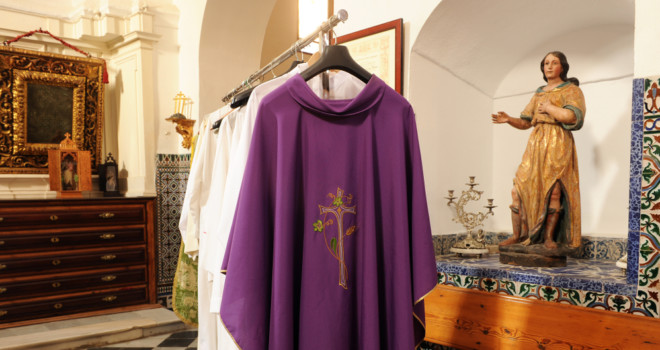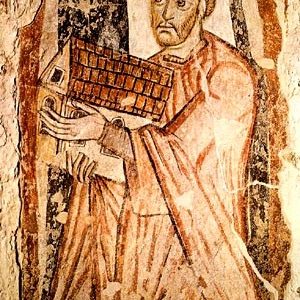This year was the second year that I had the opportunity to
sew vestments for a newly ordained friend. The vestments of a priest (the stole
and chasuble) are worn by him at Mass. The stole is also worn for any other
Sacrament or priestly function (such as at burials).
How to Sew Vestments
Before I even start to sew anything, I share a series of
texts, conversations, and emails with the priest-to-be. I give him options for
fabrics and banding and order the ones he chooses. I try out pattern pieces on him
and alter the patterns accordingly. I peruse the chasubles in the sacristy with
him, to see what style he has in mind. After all that preparation work, and
after the materials have arrived in the mail, I start sewing.
Sewing stoles requires a lot of technical ability. I’ve been
sewing since I was about six years old, and I still have a lot to learn when it
comes to sewing with a pattern. To sew a stole, you have to cut out the pattern
pieces – one set from the front fabric of the stole, and another set from the
backing fabric of the stole. You then sew the front and back together (inside
out) and use fusible webbing (which can be attached to fabric by ironing) to
attach a stiff fabric to the interior. The whole thing is turned right side
out, and the ends are sewn closed. Then, a cross is handsewn to the very center
of the stole (which the priest kisses when putting the stole on) and banding
ribbon or an applique can also be handsewn on, along with fringe and tassels.
From start to finish, it takes hours to finish a single stole. I would estimate
the one that I sewed this year probably took at least five hours to complete
(but possibly much more, since I worked on it over the course of several days).
A chasuble varies, depending on what kind of chasuble it is.
The only kind that I have had the opportunity to sew yet is the gothic style of
chasuble (the flowy kind that most priests wear for Novus ordo liturgies).
There isn’t much technical skill involved in making a gothic chasuble. The
fabric pieces are cut out, and the banding attached. If there is a backing
piece of satin, the front and back are sewn together (wrong-side out) and then
turned right side out. The neckline is hemmed. It is all sounds simple. What
makes it complicated is the patterns on the fabric, and the sheer quantity of
fabric. If there is a pattern on the fabric being used, then the patterning
needs to line up on each side of the middle banding ribbon. The fabric used is
typically satin or damask (a sort of silky kind of fabric) and it slides around
a lot when being put through an ordinary sewing machine. It takes focus and
concentration and a lot of hand strength to make sure that it goes through the
machine straight and not crooked. If your hand slips, it is easy to make a
mistake and have to rip out a hem or seam.
The Spiritual Side
I don’t sew vestments for a living, and I’ve only sewn two
so far. Because the only vestments I’ve sewn have been for close friends of our
family – men who we have watched grow through the process of seminary formation
– I have that particular priest in my mind and heart as I sew his vestments. I
find myself praying for him as I work and thinking about who he is and who he
is becoming. When I hit a snag with my sewing machine (which seems to
constantly happen) I take a deep breath and offer up the frustration of that
moment for him. As a spiritual mother to him, I pour my love and prayers into
each stitch that I sew for him.
I also contemplate the fact that the vestment in my hands
will be worn when the Sacraments are being brought to people. I marvel at the
opportunity to play a small role in that.
Since both vestments I have sewn have been for a friend who
is about to get ordained, I also find myself contemplating the vocation that
this man is giving his “yes” to. Especially in our current culture, I am aware
of the suffering he may be asked to endure.
Seeing the Chasuble in Action
Although the friend that I sewed the first chasuble for has
sent me pictures of himself wearing it, I have never actually been to a Mass
where he is wearing it. But when I was sewing the second chasuble, my friend
told me that he was hoping to wear it for his first Mass. The first Mass of a
priest is no small affair, and I was both excited and nervous at the thought of
him wearing it for that occasion.
I was tweaking that chasuble up until the night before
ordination. Not having him in town to try it on, I had to do my best trying to
figure out if it would fit him. Up until the last minute I was trying to figure
out how to make the neckline right and was tearing out stitches to reconfigure
it. I hoped he would like it, and that it wouldn’t look awful. I didn’t have a
chance to see his reaction to it beforehand, because I just handed it off to
another priest in his religious community and asked him to get it safely to my
friend.
The morning of his first Mass I was so nervous. What if the
chasuble didn’t fit right? What if I had messed it up?
My newly ordained friend processed in, wearing that chasuble
that I had toiled over for so many hours, and it looked…beautiful. It fit
him. It looked like a real chasuble, and the gorgeous fabric and banding he
chose looked stunning. I felt so relieved.
Having never seen a priest wearing vestments I had sewn, I
was also mesmerized. I could look at that chasuble and picture every stitch,
every mistake, every time that I was convinced I had ruined the entire
chasuble. I can sew, but I am not an expert by any stretch of the imagination.
Yet there, up on the altar, was a priest wearing the
chasuble I had sewn. What I had worked on in my ordinary home, on my ordinary
sewing machine, with my ordinary and pin-pricked fingers was being used as part
of the sacrifice of the Mass.
That moment has become an image for me of the way that the
priest and laity are similar. My ordinary work was transformed when it was
brought into the Mass. Likewise, my friend – an ordinary man – was transformed
by the sacrament of Holy Orders. Through an ordinary man, God would give us the
gift of his Body and Blood.
Through ordinariness, weakness, and imperfection, God was choosing to work. He takes the ordinary things we offer to him – especially every little sacrifice – and unites them to himself. Priest or laity, we bring God our ordinary selves and we trust that he will conform us to himself.
✠












